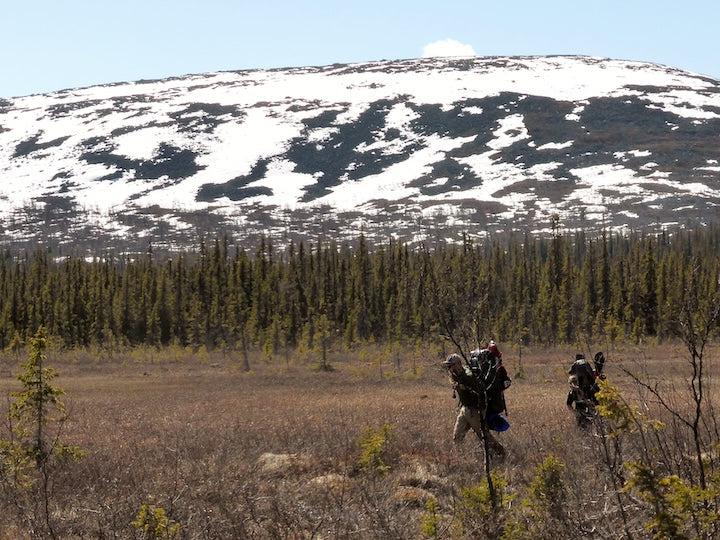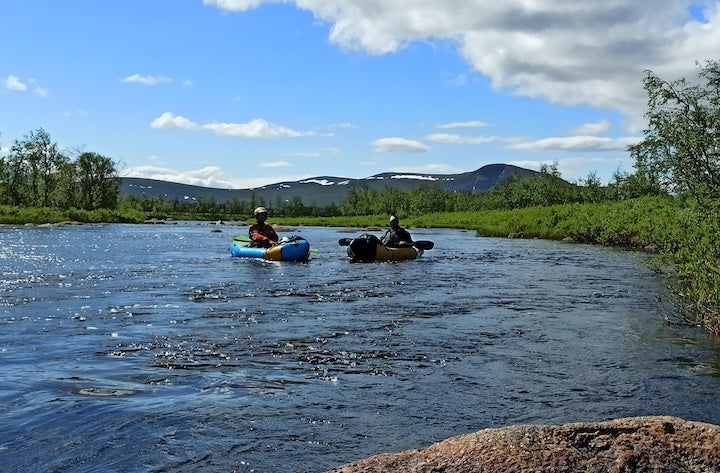Packrafting in Swedish Lapland
5-minute read
Aqua Bound Ambassador Peter Tjärnlund frequently packrafts the rivers of Swedish Lapland. We asked him to tell us more about this remote and beautiful wilderness area and what it’s like to packraft there.

Packrafting trip in Sweden’s Muddus National Park
Here’s our interview with Peter:
AQUA BOUND: What is the terrain like in Swedish Lapland?
PETER: Swedish Lapland is about 1/4 (110.000 km2) of the entire surface of Sweden. It borders Norway in the west (mountain range) and Finland in the north (tundra). South of the tundra and east of the mountain range we have the boreal forest. That gives three different kinds of terrain: mountains, tundra and boreal forest. That also gives possibilities for completely different trips.
About half of Swedish Lapland is above the Arctic Circle. You can almost compare Swedish Lapland to Alaska. A smaller and a little bit more population-dense Alaska.
AQUA BOUND: Do you packraft on mostly lakes, mostly rivers or both?
PETER: I mainly paddle rivers. Since we have a lot of rivers and I find lake paddling utterly boring, I mainly aim for rivers when I paddle. But you can´t ditch boring lake paddling since most rivers also have different sizes of lakes in them.

Packrafting the Råne River
AQUA BOUND: What do you have to think about for your packrafting trips in Lapland compared to other destinations?
PETER: When planning trips in this area you must understand that most rivers are very remote. You seldom paddle through populated areas. Public transport can also be a big issue when planning. Many areas have no kind of public transport so then you need to figure out some kind of car shuttle to be able to paddle some rivers.
Since it is very remote you need to be able to take care of yourself. Wilderness skills are a must. There are no camping places, so wilderness camping is the only way to go. You need to be very rigorous about safety. In case something goes wrong, the only way to get outside help is by PLB (Personal Locator Beacon) since most places have no cellphone coverage.
You need to carry all your food with you since there is no possibility of filling up on the way. Fishing can often be a way to get extra food. Just make sure you have the correct permits before you fish.
The weather is pretty stable in this area, but you always need to be prepared for rain and night temperatures that can be below zero, even in summer—and especially in the mountains. In this area, the mosquitos can be bad. Usually, the worst time is from midsummer (late June) until the beginning of August. After that, it gets better.
AQUA BOUND: What does a typical packraft trip there look like for you?
PETER: You can find a lot of different trips in this area, anything from day trips to 14-day trips. Some rivers you can access by car, but those rivers are seldom what I would call wilderness rivers. Most of the wilderness rivers you need to hike for 1-3 days to get access to.

Backpacking-in to get wilderness river access in Sjaunja Naturreserve
AQUA BOUND: When is the best time of year to packraft there?
PETER: Most rivers start to open in early May (later in the mountains) and the season ends in late September/early October. But many rivers are shallow and need a lot of water to be able to paddle. That means the season for some rivers may be only a couple of weeks. The larger the river, the longer the season.
When I plan trips, I aim for the smaller rivers during their respective spring flood. Since the spring flood happens at different times in such a large area, it is possible to paddle the small rivers from early May to early July. The rest of the time—July through September—the bigger rivers are a better option unless there are heavy rains that can give small rivers enough water.
Along the mountain range, some rivers get their main water source from glaciers. That gives the opportunity to paddle those rivers during summer since the glaciers melt mostly during the hot summer.

Packrafters can find rivers with enough water to paddle throughout the season, depending on their size and location (this is the Vittangi River)
AQUA BOUND: What kinds of wildlife (and humans) are you likely to encounter in the Swedish Lapland wilderness?
PETER: There are big predators in this area like bears, wolverines, lynx and a few wolves. But these predators are not as aggressive as they can be in other areas of the world. A normal encounter with these predators is that you might see their tracks and poo but you will never see the actual animal. They have seen you first and walked away.
Other wildlife that is more probable to encounter are reindeer, moose and many different kinds of birds.
Since the north of Sweden, Norway and Finland is where the Sami people live, and they are mainly reindeer herders, you will most likely encounter reindeer herds. What you need to think about then is not to walk straight towards the herd. The best thing is just to stand still, take photos and wait until the herd has walked away. In case you need to pass you need to take a detour. If you walk on, the risk is that you split the herd and the mother and calves get separated. Especially at the beginning of the season (May-July), this can be lethal for the calf.
Human encounters can happen, mainly when you meet fishermen who are fishing the rivers. What you need to think about then is to wait until the fishermen have spotted you and then make sure you can pass without crossing any of their fishing lines.
* * * * *
Thank you to Peter for his time and photos! You can follow his adventures in Swedish Lapland and other northern Scandinavia destinations on Instagram and YouTube.
All photos courtesy of Peter Tjärnlund.
What paddling questions can our friendly Customer Service team help you with? Contact us here: 715-755-3405 or [email protected]
More for you...





